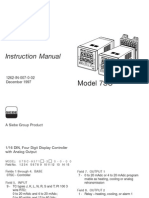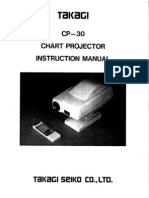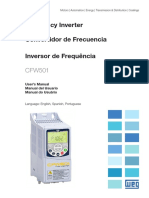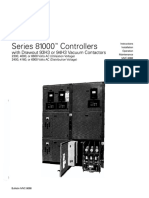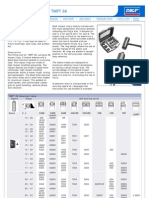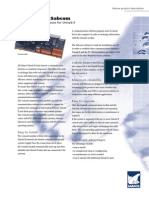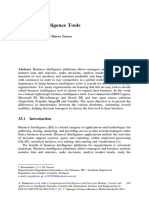Elettronica S.R.L.: Thermal Protection Device For Electric Units
Elettronica S.R.L.: Thermal Protection Device For Electric Units
Uploaded by
andy175Copyright:
Available Formats
Elettronica S.R.L.: Thermal Protection Device For Electric Units
Elettronica S.R.L.: Thermal Protection Device For Electric Units
Uploaded by
andy175Original Description:
Original Title
Copyright
Available Formats
Share this document
Did you find this document useful?
Is this content inappropriate?
Copyright:
Available Formats
Elettronica S.R.L.: Thermal Protection Device For Electric Units
Elettronica S.R.L.: Thermal Protection Device For Electric Units
Uploaded by
andy175Copyright:
Available Formats
NEX
Thermal protection device for electric units
4 analog input channels, 4 output relays
USERS MANUAL
Elettronica S.r.l.
The ALMA Elettronica S.r.l.company can modify the device and
this manual without notice
Manual Code M0002
Figure Index 4
Introduction 5
Device Overview 5
Technical specifications 6
Cutions 7
Installation Instructions
8
Device and accessories description 8
Frontal panel 8
Back panel and accessories 9
Mechanical installation 10
Electrical connections 10
Power Supply 10
Relays outputs connection 11
Probes connection 11
Instructions for use 12
Visualisation and keyboard use 12
Navigation on pages 12
Programming 13
Description of programmable data 15
Solution of problems 18
Guarantee conditions 20
Appendix A 21
Index
3
Figure index
Figure 1 Transformer with probes 5
Figure 2 Front view 8
Figure 3 Rear view and accessories 9
Figure 4 Dimensions 10
Figure 5 Electrical connection 10
Figure 6 Probes connection 11
Figure 7 Navigation on pages 12
Figure 8 Alarm working show 16
Figure 9 Power supply 21
4
Introduction
Congratulations for your choice to purchase , the electronic device for
temperature monitoring.
This manual gives you the information you need when you install and configure the
device.
For a useful usage of this manual, we suggest you to read it standing near to the
device to directly verify the instructions.
The device comes into begin to satisfy the insulated resin transformers or dry
type transformers user's requirements.
In details the device characteristics are:
for resistive probes Pt100 to measure 4 temperatures:
the temperatures in the three transformer columns and the one in the core (see
figure 1).
, for the visualization of all the
4 measured temperatures. In this way we obtain the whole temperature situation
in only one visualization.
with 4 keys to programsetup parameters.
.
to perform 3 alarm levels equal for all the inputs, and a general
alarm to signal operation anomalies in the device or in the probes. The 3 alarm
levels are useful to drive fans, external signalings (as lights or sirens), and the
unhook of the electric unit fromthe electrical line.
The system performs useful reading of the measured temperatures and a very easy
definition of the control parameters.
The device has been realized compliance with the electromagnetic
c o m p a t i b i l i t y
requirement.
NEX
NEX
NEX
NEX
NEX
NEX
Device Overview
!
!
!
!
!
4 analog input channels
backlighted LCD display 16 characters x 2 lines
Membrane keyboard
Non volatile data storage
4 output relays
Probe A
Probe D
Probe B Probe C
5
Figure 1
Technical specifications
Power supply
Inputs
Outputs
Device dimensions
Performances
!
!
!
!
!
!
!
!
!
!
!
!
!
!
!
!
!
!
!
!
nominal line voltage and frequency: 24 250 Vcc and Vac at 40 60 Hz
Maximumline voltage from20 to 260 Vcc and Vac
Vcc with reversible polarity
Maximumpower absorption 7 VA
Protection against electrical and magnetic noises
4 analog input channels for three wires Pt100 probes compliance with
requirement DIN 43760. The operator can de-activate the 4th channel from
programming
connection with removable terminals for wires of 1,5 mm section
cables length compensation up to 500 m(1 mm section)
detection for broken or not connected probes
input channels protected against electromagnetic noises and spikes
4 output relays with contacts capacity of 5A with 250Vac
one relay for the 1st setpoint level (for fan control)
one ralay for the 2nd setpoint level (pre-alarm)
one relay for the 3rd setpoint level (unhook of the electrical unit)
one relay for probe fault or working anomaly signaling (general alarm)
output connection with removable terminals for wire of 1,5 mm section and
capacity of 8A/250 Vac
frontal dimension 96 mm x 96 mm compliance with DIN 43700 requirements.
Device length of 105 mmwith rear terminals
assembling on the front of the electric panel
panel cut-out 92 mmx 92 mm
ABS self-extinguishing container
Frontal panel in anti-scratch polyestere with keyboard and signal leds
Temperature monitoring from20Cto 200C
Temperature measurements accuracy 0,5%full scale, 1 digit
Digital linearity of probe signal compliance with DIN 43760 requirements
2
2
2
-
-
-
-
6
!
!
!
!
!
!
!
!
!
!
!
!
!
!
!
!
!
!
!
!
!
!
Self-diagnostics
Operating temperature range from5Cto 50C
Humidity lower then 95% no-condensing
Compliance with CE requirement
User data storage for 10 years without power supply
Device functionality self-diagnostic
Alarmsignal for working anomalies or wrong user data definition
backlighted LCD display 16 characters x 2 lines, for the visualization of all the 4
measured temperatures
3 leds indicating alarmlevels
1 led indicating working anomalies or probe fault
user data programming by membrane keypad
automatic exit fromprogramming procedure after 30 seconds of no operation
3 temperature levels programming for 3 input channels
3 temperature levels programming for the 4 input channel
hysteresis, alarmmemory, delay and impulse data programming
notification for wrong user data statements
stated data recall and visualization by the membrane keypad
maximummeasured temperature storage for each input channel
memory alarmreset by membrane keypad
avoid power supply out of the device nominal range
use shielded cables for the probes
avoid the device working in room with conditions out of the nominal ones
previously reported and in particular in presence of condensing humidity.
Displaying and data management
th
Cautions
7
InstallationInstructions
For a right operation, the device has to be installed compliance to the
requirements reported in the Technical Specifications paragraph.
The device provides fixing accessories and removable terminals for electrical
connections.
Figure 2 represents the scheme of the device.
1. Backlighted LCD display 16 characters per 2 lines. It allows the simultaneous
visualization of the measured temperatures. It is possible to visualize and modify
the alarmsets using the keys.
2. Leds A1, A2, A3 point out the corresponding alarm activation due to the
exceeding of the alarmsets by one of the measured temperatures.
3. led points out anomalies. This led lights up in these cases:
NEX
General Alarm
The self-diagnostics program pointed out an anomaly
Device andaccessories description
Frontal panel
-
front view
A1
NEX
A2 A3
Elettronica
7
3
1
2
4
5
6
8
Figure 2
-
-
There is a damaged or not connected probe
The systemis in no-active control (data programming modality)
4. Second function key. Pressed with the confirming key (7) it allows to enter
the programming modality; in this modality it allows the shift on number to be
modified.
5. Decrease key. Out of the programming modality it allows the navigation in
the data visualization pages. In the programming modality it allows to decrease
the value of the programming datum.
6. Increase key. Out of the programming modality it allows the navigation in the
data visualization pages. In the programming modality it allows to increase the
value of the programming datum.
7. Confirming key. In the programming modality it confirms the set datum.
1. Connector for probes connection
2. Connector for the relay outputs
3. Power supply connector
4. Removable terminals for the wiring harness
5. Clips for the device clamping.
v
u
t
Back panel and accessories
Rear view and accessories
1
2
3
4
5
6
7
8
9
10
11
12
13
14
15
16
17
18
19
20
21
22
23
24
25
26
27
3
2
4
5
1
13
14
15
16
17
18
19
20
21
22
23
24
1
2
3
4
5
6
7
8
9
10
11
12
25
26
27
A
B
C
D
A1
A2
A3
E
l
e
t
t
r
o
n
i
c
a
9
Figure 3
Mechanical installation
Electrical connections
The device provides a black self-extinguishing ABS container. The device
dimensions are compliance to the standard of DIN 43700: 96 mm x 96 mm section
and a maximumdepth of 105 mm.
The dimensions of the panel perforation are 92 mm x 92 mm. The fixing is carried
out using the clamps provided with the device.
See Figure 4.
All the connections are carried out with the removable terminals provided with the
device for a simplified wiring harness. For the wiring harness you can refer to the
figure 5 and to the
terminals numeration.
Th e p o we r s u p p l y
connection is performed
connecting the power
voltage to the terminals
25 and 27 without any
respect of polarity for
Vcc.
The nominal allowed
voltages are in the 24 Vcc
240 Vcc range for the
direct voltage, or in the
24 Vca 240 Vca range
with 50 Hz frequency for
the alternate voltage.
Terminal 26 has to be
connected to the ground
reference.
The device power supply
NEX
Power Supply
A1
NEX
A2 A3
Elettronica
26,32 mm
2
6
,
3
2
m
m
2
4
,
2
7
m
m
24,27 mm
27,01 mm
24,54 mm
2
4
,
0
3
m
m
8
9
,
5
x
8
7
,
5
m
m
105 mm
95 mm
96 mm
9
6
m
m
92 mm
9
2
m
m
1 2 3 4 5 6 7 8 9 10 11 12
13 14 15 16 17 18 19 20 21 22 23 24
output relays
input probes Pt100
A1
A2
A3
General
allarm
probe A probe B probe C probe D
red
red
white
probe Pt100
25 26 27
power supply
10
Figure 5
Figure 4
is protected frommomentary input over-voltages.
The device does not provide internal fuses, so that you must provide an external
adequate protection.
Figure 5 shows the position of the relays not excited (turned off device).
The alarm relays are excited when one of the probes exceeds the set limit. The
relay operates in intrinsic security, so that it is excited at the device
switching on, and it is de-excited when conditions that compromise the device
functionality take place. In this way when the device is switched off you have the no-
active control signal.
The analog inputs are compatible with three wires Pt100 resistive probes.
For the sensors connection we suggest you the following expedients:
use a shielded cable to connect the probe with the device and with the shield
fixed to the ground reference inside the electric panel
the connection cables route has to be separated from the high-tension cables and
fromcables driving inductive elements as remote-control switch
the 3 wires of each probe will have the same length and section so that they have
all the same line resistance. The line resistance will be lower than 10 ,
corresponding to a wire of 500 meters length and 1 mm section. It is also
possible to use 2 wires Pt100 probes making a link on the terminals for the line
resistance measure, as shown in figure 6. In that case the temperature's measure
will be affected by an error as large as longer is the probe connection cable.
The damage due to a wrong power supply is not covered by guarantee.
Relays outputs connection
Probes connection
General Alarm
!
!
!
W
2
1 2 3
probe a
3 wires
1 2 3
probe a
2 wires
jumper
11
Figure 6
Instructionsfor use
Visualizationandkeyboarduse
On the device the measured temperatures and the set data visualization is done
by the navigation on pages by keyboard. Besides this kind of visualization has a very
intuitive use, it allows the simultaneous visualization of data related to the same
ambit.
Navigation on visualization pages takes place using the increase and decrease keys
referred to with symbols.
Pages are cyclically placed: when you arrive to the last page you directly go to the
first one (see figure 7). Referring to the scheme, with the key you run the pages
clockwise, whereas with the key you run the pages anticlockwise.
The usually visualized page is page 1, which is the principle one. It shows the
temperatures measured by the probes. The device visualizes this page at the
switching on and every time it is standing for a time greater than 30 seconds (no key
pushed).
visualizes the maximumvalues of temperatures measured by each probe.
visualizes the three alarm levels setpoints programmed for probes A, B and
C.
visualizes the three alarm levels setpoints programmed for probe D. If lines
NEX
Navigation on pages
and t u
u
t
Page 2
Page 3
Page 4
DEFAULT DATA ?
YES/NO
ENABLE
PROBE D ? YES/NO
MAX A 888B 888
C 888D 888
LIGHT ALWAYS ON?
YES/NO
A 888 B 888
C 888 D 888
HYS 88 DEL 88s
IMP 88s AUT 0
set D A1 888
A2 888 A3 888
set ABC A1 888
A2 888 A3 888
1
2
3
4
4b
5
6
7
12
Figure 7
appear instead of numbers, it means that the D probe has been de-activated by
programming. Entering the programming modality from this page, you go to
that allows the activation or de-activation of the D probe.
visualizes the hysteresis, delay, alarmmemory and impulsive release data.
provides the loading of the data set usually fornished with the device.
In you can choose the operation of the display backlighting: always or
limited-time alight.
The programmable data can be modified following a procedure, later on described,
that allows to intuitively set data in little groups.
Data are visualized collected in pages as described in the previous paragraph. To
modify one of these groups you must followthe next procedure:
using keys (as indicated in the previous paragraph) you can choose the
visualization page containing the data to be programmed (for example, page 3 in
figure7)
simultaneously pushing and keys you can enter the programming
modality.
In the programming modality, according to the data group, either a guided page with
specific questions or the same page with a flashing cursor standing on a cipher of the
first datum to be modified, appears. The programming modality entry is easily
recognizable, because also the led lights up to signal that the device is
no more in the active-control modality.
Once you entered the programming modality, a flashing cursor appears on one of the
visualized data. Using keys it is possible to increase, decrease or anyway
modify. For numerical data it is possible to shift the cursor to the next cipher pushing
the key. The shift is cyclical: keeping on pushing the key you pass through all
the datum ciphers and after the last one you return to the initial one. This is usefull to
correct erroneous sets. When the datum definition is completed, you must confirm it
pushing the key and the cursor will shift on a cipher of the next datum. If you don't
want to modify the datumit's sufficient to confirmit pushing the key.
Once you have confirmed the last programmable data of the visualized page, the
device carries out a conformity test of the set data: if the test is positive, the set data
are storaged and the device leaves the programming modality and returns to the usual
visualization modality.
If the data test is negative an error signal appears and the device doesn't leave the
programming modality showing the same page to correct data.
The exit from the programming modality can occur also for inactivity, if nobody
pushes a key for at least 30 seconds. In that case the device ignores the data
modifications eventually done and restores data set before entering the programming
modality.
page
4b
Page 5
Page 6
page 7
Programming
!
!
t u
v
t u
v v
and
and
General Alarm
13
You have to program even not numerical data using the keys and confirm
themby the key.
A brief description of each page programming follows:
in of figure 7 in the programming modality, simultaneously pushing the
and the keys, you can modify the maximum temperatures reached by each
acquisition channel. You can only put these data at zero. Entering the
programming modality the four maximum values will be simultaneously put at
zero. Anyway you won't see zeros because the device, once you have finished
the zero setting, will do a comparison with the measured temperatures that will
surely be greater so that the maximumvalues will immediately be updated.
in of figure 7 in the programming modality, simultaneously pushing the
keys, you can modify the temperature levels relative to the three A,
B and C probes alarms. The data modification modality is the general one
described above. The A1 threshold is the first alarm level, the A2 threshold is the
second one and the A3 one is the last level ( ).
in of figure 7 in the programming modality, simultaneously pushing the
keys, you can go the 4b page that allows the D probe activation or
de-activation. This probe is usually joined to the transformer's core, but
sometimes it's not installed. In that case you have to de-activate the probe from
programming to avoid the system's signal of an alarm for the disconnected
probe. You can decide to activate or de-activate the D probe using the
keys. If you activate the probe, you go to the temperature's thresholds
programming page for the alarms: as for A, B and C probes the A1 threshold is
the first alarm level, the A2 threshold is the second one and the A3 one is the last
level ( ).
in of figure 7 in the programming modality, simultaneously pushing the
keys, you can set a series of data whose meaning is specified in the
paragraph.
in page 6 of figure 7 in the programming modality, simultaneously pushing the
keys, you can restore the standard data. In the programming
modality it's necessary to answer 's' or 'no' using the keys.
in of figure 7 in the programming modality, simultaneously pushing the
keys, you can choose two different options for the backlighting of
the display. In the programming modality it's necessary to answer YES or NO
using the keys. If you answer YES the display will be always lighted.
If you choose the second operation modality the backlighting will be usually
turned off and will be turned on for a short time when the user pushes any key.
Entering the programming modality, if you simultaneously push the
keys in the of figure 7, you can cancel the alarms in case the alarm memory
has been programmed (see the paragraph).
and
and the
and the
and the
and the
and the
and
and the
and
and the
t u
v
v
v
t
u
v
v
t u
v
t u
v
!
!
!
!
!
!
page 2
page 3
page 4
page 5
page 7
page 1
transformer's uncoupling
transformer's uncoupling
Description of programmable data
Description of programmable data
14
When the programming data modality is activated the system is
in no-active control modality, so that the relays are de-excited
and the No-active control/General alarm led lights up.
Description of programmable data
The programmable data are the following ones:
for the ABC probes: the exceedings of those levels
excites the alarms A1, A2 and A3. On these data a condition is present: the value
of A1 has to be lower than the value of A2 and this one has to be lower than that
of A3. If you don't respect this condition, the system signals an error and doesn't
permit the exit fromthe programming modality.
for the D probe: the exceding of the set levels excites the
alarms A1, A2 and A3. There is a condition on this data: the value of A1 has to
be lower than that of A2, whose value has to be lower than that of A3. If you
don't respect this condition, the system signals an error doesn't permit the exit
fromthe programming modality.
A unique datum for all the programmable temperature thresholds. It
avoids the alarms to switch on and off closely in time because of temperature
oscillation around the temperature setpoint. This data appears as HYS in page 5
of the Figure 7.
A datum to excite each alarm when a temperature threshold is exceeded: it
represents the minimum time the temperature has to spend over the setpoint for
the alarm activation. It avoids the alarms to be activated for temporary
exceedings of the temperature setpoint. This data appears as DEL in page 5 of
the Figure 7.
for the alarms also when the temperature returns under the
corresponding threshold value. You can select this option when you want to
verify the alarm causes: in fact, in this case the alarm has to be de-activated by
hand using the keys on the frontal panel. This data appears as AUT in page 5 of
the Figure 7.
length. It is activated only on the A3 alarm and you have to use it only if
you have a throw coil isolator for the electric unit's unhooking. The relay
corresponding to the A3 alarm (unhooking) will be closed for a number of
seconds equal to the impulse length. If you don't want the relay to close you have
to set this datum equal to zero. This data appears as IMP in page 5 of the Figure
7.
Figure 8 shows the significance of the programmable data above described.
In the figure, on the horizontal axis is represented time and on the vertical one
temperature.
The horizontal lines correspond to the programmable temperature setpoint and this
!
!
!
!
!
!
3 temperatures setpoint
3 temperatures setpoint
hysteresis
delay
Alarm memory
Impulse
15
datum minus the hysteresis (the dashed line). In the bottom of the figure is
represented the alarmsituation, which means the corresponding relay's shut down.
At time T the curve representing temperature exceeds the setpoint, but the alarm
doesn't activate because temperature returns under the setpoint before the set delay
time T 's term. In this way you avoid the corresponding threshold activation when
you have very fast transients.
At time T the curve representing temperature exceeds again the setpoint and after
the set delay, at time T , the output channel is activated.
At time T the curve representing temperature goes under the setpoint, but the alarm
is de-activated at time T when it goes under the value of the setpoint minus
hysteresis.
It follows the list of data with the corresponding minimum and maximum
programmable value:
1
2
3
4
5
6
T
e
m
p
e
r
a
t
u
r
e
Time
on
off
alarm status
a
l
a
r
m
s
t
a
r
t
a
l
a
r
m
e
n
d
setpoint
hysteresis
delay
delay
T
3
T
4
T
6
T
5 T
2
T
1
16
Name of
Datum
Min.
Programm
able
value
Max.
Program
mable
Value
Standard
Values
Notes
SET ABC A1 0 C 199 C 100 C First alarm level for A, B e C
probes
SET ABC A2 0 C 199 C 120 C This datum has to be greater
than SET ABC A1
SET ABC A3 0 C 199 C 135 C This datum has to be greater
than SET ABC A2
SET D A1 0 C 199 C 110 C First alarm level for D probe
SET D A2 0 C 199 C 130 C This datum has to be greater
than SET D A1
SET D A3 0 C 199 C 145 C This datum has to be greater
than SET D A2
MAX A 0 C 0 C 0 C Only zero setting
MAX B 0 C 0 C 0 C Only zero setting
MAX C 0 C 0 C 0 C Only zero setting
MAX D 0 C 0 C 0 C Only zero setting
HYSTERESIS 0 C 99 C 5 C
DELAY 0 sec 99 sec 0 sec
ALARM
MEMORY
(AUT)
0 1 0 If it is equal to 1 there is
alarm memory, if it is equal
to 0 there is not
IMPULSE 0 sec 99 sec 0 sec
If it is equal to 0 the
unhooking relay stays closed
for the alarm lenght. If it is
not equal to 0 the unhooking
relay stay closed only for a
time, in seconds, equal to the
set value (impulse)
p
a
g
i
n
a
t
a
4
p
a
g
i
n
a
t
a
3
p
a
g
i
n
a
t
a
5
p
a
g
i
n
a
t
a
2
17
Solutionof problems
In this paragraph we give you some suggestions to solve anomalies you can meet
using the device. NEX
Problem Solution
The NEX device doesnt
turn on
Verify the connection to the power supply.
Verify there is line voltage.
Verify that the power supply values are compliance
with those specified in this manual.
If the problem persists please contact the device
distributor.
The device emits the
General Alarm signal
Verify there is no error messages on the display.
Verify the suitable connection of probes.
Verify that the device is not in the programming
modality. In this case wait 30 seconds before touching
any key: the device will automatically exit this
modality and turn back to the visualization one.
If the problem persists please contact the device
distributor
The device shows the
message Data Error and
doesnt exit the
programming modality
This situation occurs when at the exit from the
programming modality and the device carries out a
conformity test of the set data. If you are setting the
alarm thresholds for the probes, verify that A1<A2<A3.
If you want to exit from the programming modality
without changing data wait 30 seconds without
touching any key: the device will automatically exit
from this modality and turn back to the visualization
one re-setting the previously used data.
The probe measures a
temperature greater than
the corresponding
setpoint but the alarm
doesnt activate
Verify if the delay datum has been set.
If it has not the relay will close only after a time equal
in seconds to the delay length if temperature doesnt
undergo the set threshold before.
The A3 alarm is
activated (the led is
alight) but the relay is
de-excited
Verify that the impulse datum has not been
programmed.
18
Problem Solution
The measured
temperature is lower
than the setpoint but the
corresponding alarm is
activated
Verify the value of the set datum of hysteresis and
control if the measures temperature in lower than the
threshold minus this value: the alarm stops only when
the temperature undergoes the setpoint minus the
hysteresis value (see figure 8).
If this is not the cause of the problem, verify that the
alarm memory has been set. In this case the alarms can
be de-activated by hand the programming modality in
the principal page (see page 1 of figure 7)
In the principal page of
temperatures
visualization on the D
probe datum some
dashes appear
If on the D probe datum some dashes appear instead of
a number it means that the D probe is de-activated. To
activate it see the procedure described in the
Programming paragraph.
In the principal page of
temperatures writing
ERR appears on some
probes datum
If on the temperature datum measured by some probe
the writing ERR appears it means that the probe is
damaged or badly connected. In this situation also the
Generic Alarm signaling lights up. Test the probes
connection and try to change the connection channel to
verify if the problem its really on the probe.
19
Guarantee conditions
The thermal protection are covered by guarantee for a period of 24
months since the consignment date for anomalies due to production defects.
The guarantee consists in the free repair or substitution of the components that have
been damaged in the devices' construction, arrived at our office carriage paid.
The product's guarantee declines in the following cases:
device's damages deriving from negligence, use or installation not compliance
with the instructions furnished in the user's manual
wrong power supply
damages due to changes in the line voltage to which the device is connected as in
the case of discharges caused by thunderbolts or other external phenomena
tampering with the device
damages due to accidental causes or to negligence
non-payment of the device
The guarantee period is determined on the basis of the serial number written on the
device's label so that it has not to be cancelled nor modified.
Parts subjected to wear by use are not covered by guarantee.
Furthermore, removal and re-installation costs are not covered by guarantee, as
transport costs and risks and any other direct or indirect cost due to repair of the
device you consider damaged.
The constructor declines any responsibility for harms done to persons, animals or
things directly or indirectly coming out froma proper or improper use of the device.
The device's repair or substitution is subjected to the unobjectionable constructor's
opinion.
When the guarantee period falls the damaged device's repair will involve the debit
entry for the damaged components substitution and for the labour.
For any dispute the competent Court is the one of Bologna (Italy).
NEX devices
!
!
!
!
!
!
20
21
AppendixA
If the device is directly supplied by the secondary circuit of a medium power
transformer it is possible for the device to be crushed by a over-voltage of high
intensity. This can occur when you insert the general switch of the installation
without load. The phenomenon is particularly evident when the is directly
supplied by the copper bars of the secondary circuit of the transformer and fixed re-
phasing capacitor batteries are present. Provide the device protection inserting an
insulating 10 VA transformer (see figure 11).
NEX
Damage due to a wrong power supply of the device is not covered by
guarantee.
Figure 9
R
S
N
T
PTC device
220 Vca - 24 Vca 10VA
MT BT
22
Notes
23
Notes
Elettronica S.r.l.
via Landa, 2/b
40050 Monte San Pietro (BO)
Italy
tel +39 51 6762544
info@almaelettronica.it
www.almaelettronica.it
You might also like
- Instruction Manual: Model 7SCDocument52 pagesInstruction Manual: Model 7SCkmpoulos100% (2)
- Compact Size and Light Weight Excellent Image Quality Wireless Remote Controller For X-Ray ExposureDocument2 pagesCompact Size and Light Weight Excellent Image Quality Wireless Remote Controller For X-Ray Exposuredavid_stephens_29No ratings yet
- Eflash: Contractual Information For Partners: Phase-OutDocument2 pagesEflash: Contractual Information For Partners: Phase-OutMoises ReznikNo ratings yet
- Wedeco UV Systems AQUADA Altima, Proxima, MaximaDocument20 pagesWedeco UV Systems AQUADA Altima, Proxima, Maximaeddysoen100% (1)
- CP-30 Instruction ManualDocument28 pagesCP-30 Instruction Manualsuryadhy100% (3)
- V1 T420 InstructionManual 830-2Document56 pagesV1 T420 InstructionManual 830-2stimaune100% (1)
- ProMinent UV InglesDocument72 pagesProMinent UV InglesGilberto Prez RomeroNo ratings yet
- B43876S9478M 1 - Ed5Document3 pagesB43876S9478M 1 - Ed5Mauricio BaronNo ratings yet
- Catalogue FX03 enDocument2 pagesCatalogue FX03 enonur_guzel6403100% (1)
- Mitsubishi Melservo MR JEDocument346 pagesMitsubishi Melservo MR JEpankaj mankar100% (1)
- Manual Vortex FoxboroDocument56 pagesManual Vortex FoxboroYadir SánchezNo ratings yet
- In-Line Brix Monitor: Instruction ManualDocument45 pagesIn-Line Brix Monitor: Instruction ManualJose Ortega LopezNo ratings yet
- SEE Electrical V7 Crack PDFDocument3 pagesSEE Electrical V7 Crack PDFValerieNo ratings yet
- WEG CFW500 HMIR Remote Serial Hmi 10001446141 Installation Guide en Es PTDocument20 pagesWEG CFW500 HMIR Remote Serial Hmi 10001446141 Installation Guide en Es PTRodrigoNo ratings yet
- Installation Guia 854xtgDocument32 pagesInstallation Guia 854xtgMario MirandaNo ratings yet
- LogicLevels PDFDocument4 pagesLogicLevels PDFsdeirNo ratings yet
- Multimetro EsticDocument28 pagesMultimetro EsticDavid Resendiz MNo ratings yet
- LG 42PC51Document40 pagesLG 42PC51videosonNo ratings yet
- WEG Cfw501 Manual Do Usuario 10001991016 Manual Portugues BRDocument149 pagesWEG Cfw501 Manual Do Usuario 10001991016 Manual Portugues BRmquaiottiNo ratings yet
- Eurotherm Chessel 6100a PDFDocument2 pagesEurotherm Chessel 6100a PDFRhondaNo ratings yet
- Philips NTRX505Document28 pagesPhilips NTRX505EulerMartinsDeMelloNo ratings yet
- Power Circuit: Power For Chip Standby Power +3V3Document12 pagesPower Circuit: Power For Chip Standby Power +3V3Joseni FigueiredoNo ratings yet
- Emco Concept Mill 55 PC-controlled Milling Machine For TrainingDocument56 pagesEmco Concept Mill 55 PC-controlled Milling Machine For TrainingTatjanaNo ratings yet
- Mech Eng DsDocument11 pagesMech Eng Ds路人丁No ratings yet
- Inertaire Oil Preservation Systems Installation, Operation, & Maintenance Guide Types RNDocument20 pagesInertaire Oil Preservation Systems Installation, Operation, & Maintenance Guide Types RNJimmy McynsNo ratings yet
- 750to850 Retrofit-A2Document38 pages750to850 Retrofit-A2이성종No ratings yet
- 1747-L40C PLC To PC Communication ManualDocument42 pages1747-L40C PLC To PC Communication Manualrapozaazul100% (1)
- IGS Sever Using OPC UADocument5 pagesIGS Sever Using OPC UAGeraldoadriNo ratings yet
- Deboning UKDocument12 pagesDeboning UKHelton OliveiraNo ratings yet
- Accutex Hq-450 - Series User's Manual - EngDocument22 pagesAccutex Hq-450 - Series User's Manual - Engrubepeto0% (1)
- Sinamics g120p Pm330 Him En-UsDocument150 pagesSinamics g120p Pm330 Him En-Usesync.energia2021No ratings yet
- Dewpro Mmy 31 Operating Manual EnglishDocument36 pagesDewpro Mmy 31 Operating Manual EnglishAnonymous zMWvcTNo ratings yet
- Engl - Anhang - PROTECHNA Fadenbruchwächter LASERSTOP 4080 - 81 SYNC Für Webmaschinen - Grafische Darstellung Der FachbewegungDocument2 pagesEngl - Anhang - PROTECHNA Fadenbruchwächter LASERSTOP 4080 - 81 SYNC Für Webmaschinen - Grafische Darstellung Der Fachbewegungmanuel8950% (1)
- Maquina de Instrumentação PDFDocument4 pagesMaquina de Instrumentação PDFhecirlene vieiraNo ratings yet
- MELT-THERM II - ENG - Rev 06Document35 pagesMELT-THERM II - ENG - Rev 06Éric Alves de Souza Neto50% (2)
- MVC 9068Document52 pagesMVC 9068Rey ArthurNo ratings yet
- FSCUT2000C Laser Cutting Control System User ManualDocument69 pagesFSCUT2000C Laser Cutting Control System User ManualJeanMartinsdeVargasNo ratings yet
- 110PAX4 Maint ManualDocument0 pages110PAX4 Maint ManualmetrobsNo ratings yet
- SKF Bearing Fitting Tool TMFT 36 PDFDocument4 pagesSKF Bearing Fitting Tool TMFT 36 PDFNang Dapi0% (1)
- Man 8055 Ord HandDocument10 pagesMan 8055 Ord Handjean bartNo ratings yet
- Somfy LT-80Document4 pagesSomfy LT-80zahee007No ratings yet
- TELES iGATE v4 9Document95 pagesTELES iGATE v4 9janorena1No ratings yet
- Users Guide ProH Rev5.0.2 101208 PDFDocument40 pagesUsers Guide ProH Rev5.0.2 101208 PDFHoracio BacasNo ratings yet
- ComsabDocument2 pagesComsababuzer1981No ratings yet
- Owner & Operator's Manual: Model No VoltageDocument20 pagesOwner & Operator's Manual: Model No VoltageMario Arturo RendonNo ratings yet
- K-PATENTS Refractive Index Brix Meter - pr-01-s PDFDocument107 pagesK-PATENTS Refractive Index Brix Meter - pr-01-s PDFvjNo ratings yet
- PIONEER Operating Manual (Avh-2350dvd) - Eng PDFDocument80 pagesPIONEER Operating Manual (Avh-2350dvd) - Eng PDFel fatih100% (1)
- Gefran GTF Xtra ManualDocument29 pagesGefran GTF Xtra ManualjilfNo ratings yet
- Po 3091033258-Sjd ArchitectsDocument11 pagesPo 3091033258-Sjd ArchitectsSpace designNo ratings yet
- Netdiag White PaperDocument45 pagesNetdiag White PaperjavierleraNo ratings yet
- Installation Operation Maintenance Technical Instruction: Medium Voltage DistributionDocument28 pagesInstallation Operation Maintenance Technical Instruction: Medium Voltage Distributionsilviolima34No ratings yet
- Et200sp Ai 4xrtd TC 2 3 4 Wire HF Manual en-US en-USDocument73 pagesEt200sp Ai 4xrtd TC 2 3 4 Wire HF Manual en-US en-USAli HadiNo ratings yet
- Msa 300Document10 pagesMsa 300ferchllNo ratings yet
- Iq DatasheetDocument8 pagesIq Datasheetapi-170472102No ratings yet
- Allied Catalog For Email 2019Document87 pagesAllied Catalog For Email 2019sigurdur hannessonNo ratings yet
- Sassass3 TSX1 Eng Manual PDFDocument10 pagesSassass3 TSX1 Eng Manual PDFcxrxixsxNo ratings yet
- Ai 500501Document10 pagesAi 500501umeshNo ratings yet
- A5000 Instruction ManualDocument6 pagesA5000 Instruction ManualTandin IgorNo ratings yet
- Altronic Loop Controller Installation & Operating Manual MODEL DE-1500 FORM DE-1500 IOI 8-03Document25 pagesAltronic Loop Controller Installation & Operating Manual MODEL DE-1500 FORM DE-1500 IOI 8-03wcuevasmNo ratings yet
- Industry Guidelines: Identification of Buried Pipe SystemsDocument13 pagesIndustry Guidelines: Identification of Buried Pipe Systemsandy175No ratings yet
- PreventDocument9 pagesPreventandy175No ratings yet
- EMEA WC Sec 6Document55 pagesEMEA WC Sec 6andy175No ratings yet
- E3000 GB 3406Document100 pagesE3000 GB 3406lsilverNo ratings yet
- 01 PressacaviDocument42 pages01 Pressacaviandy175No ratings yet
- Calcined Alumina - Technical Specification 2012Document1 pageCalcined Alumina - Technical Specification 2012andy175No ratings yet
- Atasheet Liycy Electronic Control Cable With Tinned Copper BraidingDocument3 pagesAtasheet Liycy Electronic Control Cable With Tinned Copper Braidingandy175No ratings yet
- Compound Water Meter Model M-WT: ARAD LTD. DALIA - Water Meters DivisionDocument2 pagesCompound Water Meter Model M-WT: ARAD LTD. DALIA - Water Meters Divisionandy175No ratings yet
- Relay Card: InterfaceDocument2 pagesRelay Card: Interfaceandy175No ratings yet
- (Distillation) - Packed Distillation ColunmDocument12 pages(Distillation) - Packed Distillation Colunmandy175No ratings yet
- KFD0-CC-1: 1-Channel Current/ Voltage ConverterDocument1 pageKFD0-CC-1: 1-Channel Current/ Voltage Converterandy175No ratings yet
- Powerware Chassis: ExpansionDocument2 pagesPowerware Chassis: Expansionandy175No ratings yet
- Powerware Card: Multi-ServerDocument1 pagePowerware Card: Multi-Serverandy175No ratings yet
- Emp Data SheetDocument2 pagesEmp Data Sheetandy175No ratings yet
- Powerware Card: ModbusDocument2 pagesPowerware Card: Modbusandy175No ratings yet
- Powerware 9: FeaturesDocument2 pagesPowerware 9: Featuresandy175No ratings yet
- 9340 EmeaDocument2 pages9340 Emeaandy175No ratings yet
- Powerware 9 UPS: FeaturesDocument4 pagesPowerware 9 UPS: Featuresandy175No ratings yet
- Powerware 9355 Uninterruptible Power System: FeaturesDocument2 pagesPowerware 9355 Uninterruptible Power System: Featuresandy175No ratings yet
- Powerware 9370 Uninterruptible Power System: Product SnapshotDocument2 pagesPowerware 9370 Uninterruptible Power System: Product Snapshotandy175No ratings yet
- NB Error Codes TroubleshootingDocument18 pagesNB Error Codes TroubleshootingJames FigueroaNo ratings yet
- 20764C 08Document28 pages20764C 08douglasNo ratings yet
- Data Mining Important QuestionsDocument5 pagesData Mining Important QuestionsPrakash Chandra100% (1)
- OWASP Backend Security Project 1.0betaDocument184 pagesOWASP Backend Security Project 1.0betaMobile TesterNo ratings yet
- CS878 - Lab 1Document5 pagesCS878 - Lab 1Muhammad Waleed KhanNo ratings yet
- SQL Server 70 764 NotesDocument41 pagesSQL Server 70 764 NotesMatt BNo ratings yet
- Form BUKUDocument9 pagesForm BUKUIqbal AgistanyNo ratings yet
- It Is Object Level CommandDocument7 pagesIt Is Object Level CommandDileepNo ratings yet
- Database Systems Design Implementation Management 12th Edition Carlos Coronel Ebook All Chapters PDFDocument52 pagesDatabase Systems Design Implementation Management 12th Edition Carlos Coronel Ebook All Chapters PDFyoumiiishtar100% (4)
- IBM WatsonxDocument23 pagesIBM WatsonxmiNo ratings yet
- Midterm PracticeDocument7 pagesMidterm PracticeZhang YoudanNo ratings yet
- Cloud Database Battle: AWS vs. DIY vs. Oracle: By, David FloyerDocument14 pagesCloud Database Battle: AWS vs. DIY vs. Oracle: By, David FloyervenkyNo ratings yet
- Interleave MemoryDocument2 pagesInterleave MemoryJoem GutierrezNo ratings yet
- All Mark SchemsDocument11 pagesAll Mark SchemsSheniqua GreavesNo ratings yet
- An Study of Talent ManagementDocument16 pagesAn Study of Talent Managementswapnil khobragadeNo ratings yet
- Sort Date Field in XML Publisher TemplateDocument2 pagesSort Date Field in XML Publisher TemplateSuneelTejNo ratings yet
- Logcat CSC Update LogDocument322 pagesLogcat CSC Update Logangelobarahona266No ratings yet
- Academic Research Record Keeping Best Practices.10Document6 pagesAcademic Research Record Keeping Best Practices.10TimKellerNo ratings yet
- 1 - Assignment 01 570Document22 pages1 - Assignment 01 570Hải ĐoànnnNo ratings yet
- Data Management 1 - Introduction To DBMS and Relational TheoryDocument43 pagesData Management 1 - Introduction To DBMS and Relational Theorygetachew workuNo ratings yet
- Fundamentals of Database Management Systems (Cosc2041) : Introduction Database Management System Compiled By: Debritu ADocument20 pagesFundamentals of Database Management Systems (Cosc2041) : Introduction Database Management System Compiled By: Debritu ADinksrawNo ratings yet
- Introduction + Unit IDocument75 pagesIntroduction + Unit IBackup SurajNo ratings yet
- Detailed Lesson Plan On StatisticsDocument7 pagesDetailed Lesson Plan On StatisticsJaybie TejadaNo ratings yet
- Enc Encoded oWOMkQuy3I65ONYPspyA3yTb8TS8 ovCniUA3RgkGxbzwgooOMC468aFDocument128 pagesEnc Encoded oWOMkQuy3I65ONYPspyA3yTb8TS8 ovCniUA3RgkGxbzwgooOMC468aFSensei EimeyZINGNo ratings yet
- Advanced Database Management Systems Prelim Lec Exam AnswersDocument25 pagesAdvanced Database Management Systems Prelim Lec Exam AnswersKenneth MaylosNo ratings yet
- Business Intelligence ToolsDocument10 pagesBusiness Intelligence ToolsAbner AugustoNo ratings yet
- Linux MTD Subsystem With Xilinx EMC Core - HOWTODocument25 pagesLinux MTD Subsystem With Xilinx EMC Core - HOWTOprashbholeNo ratings yet
- Krishna Verma 3.2 DbmsDocument5 pagesKrishna Verma 3.2 DbmsKrishna VermaNo ratings yet
- Methods of Analysis and Criticism of Historical Data in Historical Research (1) 1Document13 pagesMethods of Analysis and Criticism of Historical Data in Historical Research (1) 1Bilal saeedNo ratings yet
- CSEDS20Document8 pagesCSEDS20Bidhan BaraiNo ratings yet
